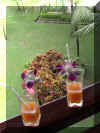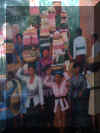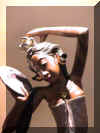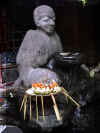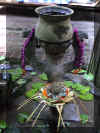



































PHOTOJOURNAL
February
4 - 11, 2001
Day 275, Sun, Feb. 4, 2001 – We arrived in Bangkok
groggy at 5:00, with no idea where we were so we made sure the meter in the taxi
was working, figuring we’d fight it out at the hotel once we got there if it
was ridiculous. We checked into the
Sheraton for the fourth time – the staff knows us by name now.
 We welcomed the hot bath and
DeliFrance sandwiches.
On CNN a Zanzibar CUF supporter was shot dead by government troops, India
is still recovering from the earthquake, and President Estrada has been driven
out of the Presidential Palace. We also
found out that Thai government troops finally captured the elusive Luther and
Johnny - the
We welcomed the hot bath and
DeliFrance sandwiches.
On CNN a Zanzibar CUF supporter was shot dead by government troops, India
is still recovering from the earthquake, and President Estrada has been driven
out of the Presidential Palace. We also
found out that Thai government troops finally captured the elusive Luther and
Johnny - the stogie-smoking, rifle-toting 12-year-olds considered living gods by
"God's Army", the Karen tribal revolutionary group from
Burma. Naomi
got Wheely Beast back and packed two UPS boxes while I wrote all day.
For dinner we went back to the waterfront for a dinner and dance show.
The food was bad, but the dancers were beautiful.
stogie-smoking, rifle-toting 12-year-olds considered living gods by
"God's Army", the Karen tribal revolutionary group from
Burma. Naomi
got Wheely Beast back and packed two UPS boxes while I wrote all day.
For dinner we went back to the waterfront for a dinner and dance show.
The food was bad, but the dancers were beautiful.
*******
Day 276, Mon, Feb, 5, 2001 –
Huge errand day of UPS shipments, camera repairs (unsuccessful again),
plane tickets and internet. We
somehow came up with 25 kilograms of crap we’d accumulated.
For our last day, we 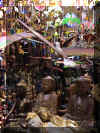 finally ran out of Sheraton points, so we moved to
the New Siam Guest House near Kho Sahn Road.
Kho Sahn has been the “tourist ghetto” of Bangkok for decades –
lined with cheap flophouses, restaurants, souvenir stands, tour guides, and fake
CDs. The neighborhood has every
conceivable
finally ran out of Sheraton points, so we moved to
the New Siam Guest House near Kho Sahn Road.
Kho Sahn has been the “tourist ghetto” of Bangkok for decades –
lined with cheap flophouses, restaurants, souvenir stands, tour guides, and fake
CDs. The neighborhood has every
conceivable  souvenir
in every possible material - including cigarette holders made of bone and
umbrella stands made of elephant feet. It was like Thamel, Katmandu
except the street was a lot wider and they restrict traffic here – there’s
also not quite as many Western restaurants. As we walked around, the locals were
watching Muay Thai boxing playing in shops and the tourists were watching DVD
movies playing in bars and restaurants. That’s
one example that globalization has not changed cultural preferences.
We made our way past the vans disgorging wave after wave of young
bohemian backpackers, to the bookstores looking for a book about Bali.
We stopped to watch a miracle worker produce perfect counterfeit student
and press identification cards (at least the kids paying $2 each hope they are
perfect enough). We had Indian
food, and then went for traditional Thai massages.
It is amazing that the country that produced the vicious and destructive
Muay Thai also produced this wonderful and rejuvenating type of massage. The
land of smiles can also be called the land of paradoxes. We looked
souvenir
in every possible material - including cigarette holders made of bone and
umbrella stands made of elephant feet. It was like Thamel, Katmandu
except the street was a lot wider and they restrict traffic here – there’s
also not quite as many Western restaurants. As we walked around, the locals were
watching Muay Thai boxing playing in shops and the tourists were watching DVD
movies playing in bars and restaurants. That’s
one example that globalization has not changed cultural preferences.
We made our way past the vans disgorging wave after wave of young
bohemian backpackers, to the bookstores looking for a book about Bali.
We stopped to watch a miracle worker produce perfect counterfeit student
and press identification cards (at least the kids paying $2 each hope they are
perfect enough). We had Indian
food, and then went for traditional Thai massages.
It is amazing that the country that produced the vicious and destructive
Muay Thai also produced this wonderful and rejuvenating type of massage. The
land of smiles can also be called the land of paradoxes. We looked 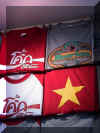 for a combination sauna/steam/massage, but
could not find any and wound up bypassing the sparkling new places with windows
on the street to patronize a more old-fashioned upstairs place.
There were five mats on the floor in a cool air-conditioned room.
We dropped our
for a combination sauna/steam/massage, but
could not find any and wound up bypassing the sparkling new places with windows
on the street to patronize a more old-fashioned upstairs place.
There were five mats on the floor in a cool air-conditioned room.
We dropped our  backpacks and the masseurs quickly went to work rubbing,
pulling, pushing, prodding. There
were two German guys on the other mats while we were getting worked over and
somebody released some gas. The
masseurs giggled, but then really dug in. She
did an incredible move stretching me backwards over her knees.
I swore it was an ancient torture position, but she said “I no hurt
you, I love you”. I said, “Well
that’s a hell of a way to show it”. We
imagined the dialogue they were having as they giggled to each other: “Boy,
this one smells”, “Oh yeah, you should get a load of this guy”, “Hey,
this one had Indian food” After being released, we felt like staying there and
sleeping – it would have been even cheaper than the hotel.
It was our last night in Thailand – land of smiles and corrupt
politics; land of angels and spicy food; land of poor people with enormous
pride.
backpacks and the masseurs quickly went to work rubbing,
pulling, pushing, prodding. There
were two German guys on the other mats while we were getting worked over and
somebody released some gas. The
masseurs giggled, but then really dug in. She
did an incredible move stretching me backwards over her knees.
I swore it was an ancient torture position, but she said “I no hurt
you, I love you”. I said, “Well
that’s a hell of a way to show it”. We
imagined the dialogue they were having as they giggled to each other: “Boy,
this one smells”, “Oh yeah, you should get a load of this guy”, “Hey,
this one had Indian food” After being released, we felt like staying there and
sleeping – it would have been even cheaper than the hotel.
It was our last night in Thailand – land of smiles and corrupt
politics; land of angels and spicy food; land of poor people with enormous
pride.
*******
Day 277, Tues, Feb. 6, 2001 – Early rise for taxi
to airport- still amazed at the condition of Bangkok roads compared to previous
trips here. It was sad since this
was the third time I'd left some things  undone
in Thailand (floating markets, diving, beaches). As we sat in the airport,
some sugar daddies were saying goodbye to their girlfriends. It was hard
to say who was more depressed - the old man who had to go back to his real
life without a beautiful young appreciative mistress or the little girl who had
to find alternative means of support for her for family. We were hoping
that we had it all wrong and he was some missionary or relief agency worker with
one of his benefactors, but unfortunately the odds are against that.
undone
in Thailand (floating markets, diving, beaches). As we sat in the airport,
some sugar daddies were saying goodbye to their girlfriends. It was hard
to say who was more depressed - the old man who had to go back to his real
life without a beautiful young appreciative mistress or the little girl who had
to find alternative means of support for her for family. We were hoping
that we had it all wrong and he was some missionary or relief agency worker with
one of his benefactors, but unfortunately the odds are against that.
*********
After a 4 hour flight to the Indonesian Islands,
we glided over the green fields and brown rivers of Bali and into Denpassar airport. We had originally planned to see much more of the 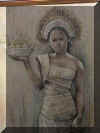 country,
but the present political situation is a bit unstable. The current
country,
but the present political situation is a bit unstable. The current  president, Wahid, a nearly-blind Muslim cleric, is in the unpleasant position of
inheriting huge expectations after the country finally got rid of the 3-decade
dictator Suharto. He now faces separatist movements in three different
provinces following East Timor's successful separation last year (which was
punctuated by military rape and pillage after the country voted for
independence). There is also significant ethnic and religious strife
in the largest Muslim country in the world, resulting in 4,000 deaths and 175
destroyed churches since Wahid took over in 1999 (including 11 on Christmas
Eve). Bali has escaped unrest mostly because it has a distinct
and heterogeneous culture that has made it a stand-alone tourist destination for
decades. After landing at the nice, clean airport, we took a taxi to
the Sheraton – another resort prison, with marble rooms and Balinese touches
like wood beams, carvings and stone statues in the extensive gardens.
We were greeted with a traditional gamelan group, a beautiful girl with flowers,
and a cool tropical drink, before being shown to our room.
president, Wahid, a nearly-blind Muslim cleric, is in the unpleasant position of
inheriting huge expectations after the country finally got rid of the 3-decade
dictator Suharto. He now faces separatist movements in three different
provinces following East Timor's successful separation last year (which was
punctuated by military rape and pillage after the country voted for
independence). There is also significant ethnic and religious strife
in the largest Muslim country in the world, resulting in 4,000 deaths and 175
destroyed churches since Wahid took over in 1999 (including 11 on Christmas
Eve). Bali has escaped unrest mostly because it has a distinct
and heterogeneous culture that has made it a stand-alone tourist destination for
decades. After landing at the nice, clean airport, we took a taxi to
the Sheraton – another resort prison, with marble rooms and Balinese touches
like wood beams, carvings and stone statues in the extensive gardens.
We were greeted with a traditional gamelan group, a beautiful girl with flowers,
and a cool tropical drink, before being shown to our room.
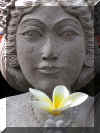 The
walls of the hotel are adorned with native paintings on canvas
The
walls of the hotel are adorned with native paintings on canvas 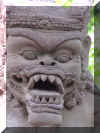 and
some exotic, graceful sculptures, while the outside grounds show the Balinese
penchant for transposing the beautiful (flowers and goddesses) with the
grotesque (demons and mythological beasts). We couldn’t quite figure out the cultural significance of
the sculptures of turtles, frogs and monkeys having sex – particularly the
carving on the bridge of a monkey having sex with a turtle. The hotel also has “the largest pool in Bali”, complete with carved bridges
and fake waterfalls, but we went
and
some exotic, graceful sculptures, while the outside grounds show the Balinese
penchant for transposing the beautiful (flowers and goddesses) with the
grotesque (demons and mythological beasts). We couldn’t quite figure out the cultural significance of
the sculptures of turtles, frogs and monkeys having sex – particularly the
carving on the bridge of a monkey having sex with a turtle. The hotel also has “the largest pool in Bali”, complete with carved bridges
and fake waterfalls, but we went  down to the beach for a couple
of hours before sunset,
after which an almost full moon rose over the sea and palms.
Took a taxi to Kuta Beach for an Italian dinner and to buy some
provisions at the market.
Kuta used to be another one of the hippie havens along the trail from
Australia to Europe, but the 8km strip along the coast is now held up as an
example of crass over development and commercialization.
It still has
down to the beach for a couple
of hours before sunset,
after which an almost full moon rose over the sea and palms.
Took a taxi to Kuta Beach for an Italian dinner and to buy some
provisions at the market.
Kuta used to be another one of the hippie havens along the trail from
Australia to Europe, but the 8km strip along the coast is now held up as an
example of crass over development and commercialization.
It still has a burgeoning surf
a burgeoning surf
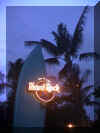 culture which started in the 60s, but it
has gone tattoo and bleached blonde, with signs for Billabong, O’Neill, Ocean
Pacific and Quicksilver all over the place. There is also an abundance of
Versace, D&G, Armani and Polo and hundreds of bars and restaurants to
accompany the guesthouses They even have one of the global Hard Rock Cafe chains,
dedicated to “Love all, Serve All” and “Save the World” because they give
a miniscule portion of their profits to charity (after their investors get rich,
of course).
culture which started in the 60s, but it
has gone tattoo and bleached blonde, with signs for Billabong, O’Neill, Ocean
Pacific and Quicksilver all over the place. There is also an abundance of
Versace, D&G, Armani and Polo and hundreds of bars and restaurants to
accompany the guesthouses They even have one of the global Hard Rock Cafe chains,
dedicated to “Love all, Serve All” and “Save the World” because they give
a miniscule portion of their profits to charity (after their investors get rich,
of course).
*********
Day 278, Wed, Feb. 7, 2001 – Slept in our paradise
of a bed until noon, then walked to a local mall for lunch.
The mall reminds us that the neighborhood we are staying in, Nusa Dua,
isn’t really Indonesia – it’s a resort on the beach that could be
anywhere. The only indication is the way dozens of salespeople follow us around
and jump into a panic whenever we touch anything.
The economy is still very bad, although not nearly as bad as in 1997 when
the country was one of the worst hit by the “Asian Flu” that strangled the
regional economies. Everyone was
blamed, from inept government and mismanaged banks to rampant spending and
foreign currency speculators. Of course, the worst hit are the lowest rung of society, who
were barely making it before the crash.
The purchasing procedures at the mall should win awards for generating
maximum employment but minimum benefit. The
kids were very sweet, though. We
walked back to the hotel to hang out until sunset, when we returned  to Kuta
where they are legendary (for good reason).
We
had a Mexican dinner at the huge cavernous place with 6 people inside.
We really miss good Mexican food – which you can’t find outside of
Mexico and the US. Someone told us Kuta was the place for full-moon parties, but we
couldn’t find one. This forced us
to make our own full moon party, floating in the ocean under a bright starry
night with clangy gamelan music from the hotel lounge playing in the background.
to Kuta
where they are legendary (for good reason).
We
had a Mexican dinner at the huge cavernous place with 6 people inside.
We really miss good Mexican food – which you can’t find outside of
Mexico and the US. Someone told us Kuta was the place for full-moon parties, but we
couldn’t find one. This forced us
to make our own full moon party, floating in the ocean under a bright starry
night with clangy gamelan music from the hotel lounge playing in the background.
********
Day 279, Thur, Feb. 8, 2001 – This Sheraton bed is ridiculously comfortable – imprisoning our initiative for most of the morning. After forcing ourselves up, we made arrangements for hotels, rental cars, and scuba diving for the rest of our stay in Bali. We are spending more time here since Java is a nightmare of protests, rioting and looting right now. Besides, it is nine months into the trip and we’re happy to be lazy for a change. Our taxi drive took us out to one of the top tourist sites in Bali – the ancient Uluwati temple site, clings to the top of a cliff 300 feet above the sound of the surf pounding the rocks below. The temple dance troupe was putting on one of the famous dances of Bali – the Kecak. Like much of the Hindu arts, the dance represents a tale from the Ramayana showing the treachery and deception of demons and the bravery and cunning of the Gods. Unlike others, however, there is no accompanying music – just the repetitive chanting of the chorus – three concentric circles of young men swaying their bodies and waving their arms as they chant. It was incredible – especially the location, as the sun set pink behind the masked dancers. The costumes were fearsome, but the highlight is really the chanting – which gets more furious as the bad guys capture Hanuman and nearly send him to a fiery death before he naturally escapes and banishes the demons. It was sort of like an old western film, with a chanted soundtrack.
After the show, I posed for a dorky tourist photo and we talked to some of the guys:
"According to me, it is happiness. In Hindu we
called it Moksha. You get it from having strong culture and religion - to
keep it alive"
Our taxi took us back, past the elaborate, baroque statue
of a Hindu God and Chariot to get our bags and we moved to Mabisa Hotel in Legian, just North of Kuta.
We could have luxuriated a little longer, but we wanted to save some
Sheraton points for later. Legian
is more our style anyway – where you can walk to everything and get a feel for
the local culture – like the famous nasi goreng fried rice dish we had – both
of us ate for the price of one drink at the Sheraton.
The people we talk to said the tourist business was OK after the crash
(since they get to spend hard, Western currency), but has tailed off now.
You wonder what Bali would be without this income – would it be like
the other islands, fighting for ethnic superiority or for autonomy from Jakarta
like so many other islands? It is a vastly diverse nation – with the world’s fifth
largest population (behind China, India, USA, and Russia) and over nearly 14,000
islands.
bags and we moved to Mabisa Hotel in Legian, just North of Kuta.
We could have luxuriated a little longer, but we wanted to save some
Sheraton points for later. Legian
is more our style anyway – where you can walk to everything and get a feel for
the local culture – like the famous nasi goreng fried rice dish we had – both
of us ate for the price of one drink at the Sheraton.
The people we talk to said the tourist business was OK after the crash
(since they get to spend hard, Western currency), but has tailed off now.
You wonder what Bali would be without this income – would it be like
the other islands, fighting for ethnic superiority or for autonomy from Jakarta
like so many other islands? It is a vastly diverse nation – with the world’s fifth
largest population (behind China, India, USA, and Russia) and over nearly 14,000
islands. 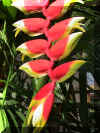 And
the cultures have been fighting each other since long before the Dutch arrived.
It was never really a unified country until the Dutch tried to corner the
lucrative spice trade by fighting off the Portuguese and English.
The Europeans reported the standard colonial “romantic” story of
beautiful paradises teeming with heathen cannibals in need of missionaries to
right their wrongs. What they
didn’t realize was that the Hindus from India and the Muslims from Arabia had beaten
them to it. The religion, culture,
traditions, song, and dance of many of the islands were handed down for centuries
– making it much harder than Africa, for example, for Christianity to take
root. Bali may be the most Hindu of
the islands since the last great Hindu dynasty retreated there from Java in the
15th century as Islam swept over most of the country.
And
the cultures have been fighting each other since long before the Dutch arrived.
It was never really a unified country until the Dutch tried to corner the
lucrative spice trade by fighting off the Portuguese and English.
The Europeans reported the standard colonial “romantic” story of
beautiful paradises teeming with heathen cannibals in need of missionaries to
right their wrongs. What they
didn’t realize was that the Hindus from India and the Muslims from Arabia had beaten
them to it. The religion, culture,
traditions, song, and dance of many of the islands were handed down for centuries
– making it much harder than Africa, for example, for Christianity to take
root. Bali may be the most Hindu of
the islands since the last great Hindu dynasty retreated there from Java in the
15th century as Islam swept over most of the country. 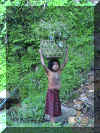 Now
the Balinese religion is one of the most complex and integrated in the world –
nearly every aspect of Balinese life – family, work, school, art, and food has a
spiritual subtext. After the
Japanese occupation during the war, the Dutch tried unsuccessfully to retake the
colony. Much like Vietnam with Ho
Chi Minh, Indonesia won independence under Sukharno, who tried something called
“guided democracy”. He is now
considered the winner of independence, but it was General Suharto, who wrestled
power from him after brutally putting down a communist coup attempt.
Suharto ruled for over three decades, building in Ferdinand Marcos style what some believe to be one of the largest fortunes in the
world for himself, his family and his cronies.
He finally resigned in 1998 - maybe fear of being ousted, maybe boredom
and exhaustion - but people fear bringing him to justice will be impossible and
the erratic President Wahid can’t win no matter what he tries.
We fear Indonesia is in for more messy politics in the near future.
Now
the Balinese religion is one of the most complex and integrated in the world –
nearly every aspect of Balinese life – family, work, school, art, and food has a
spiritual subtext. After the
Japanese occupation during the war, the Dutch tried unsuccessfully to retake the
colony. Much like Vietnam with Ho
Chi Minh, Indonesia won independence under Sukharno, who tried something called
“guided democracy”. He is now
considered the winner of independence, but it was General Suharto, who wrestled
power from him after brutally putting down a communist coup attempt.
Suharto ruled for over three decades, building in Ferdinand Marcos style what some believe to be one of the largest fortunes in the
world for himself, his family and his cronies.
He finally resigned in 1998 - maybe fear of being ousted, maybe boredom
and exhaustion - but people fear bringing him to justice will be impossible and
the erratic President Wahid can’t win no matter what he tries.
We fear Indonesia is in for more messy politics in the near future.
********
Day 280, Fri, Feb. 9, 2001 – I had a couple of scuba dives at Nusa Penida and Lembogan with a French couple and English couple with a serious Las Vegas fascination. The dives were nice, but not as good as Seychelles. I asked our dive master if he was worried about Indonesia’s future and he said, “I don’t care about Indonesia, I care about Bali”. That seems to be the general opinion in Bali – they know they have a pretty good thing compared to their neighboring islands, and would be just fine if they were left alone in their homogenous paradise.
"Working - get money for life - food,
drink. I am the only son, so I must take care of my sisters - maybe three
or four years I get married. Also I want no violence"
When I got back, Naomi had picked out an awesome Thai lunch
place where the customers lounge on huge cushy mattresses.
For sunset, we got a ride out to Tanah Lot, the most famous seaside 
 temple. It sits on rocks just
offshore so it looks like an island at high tide, but you can walk out to it at
low tide. It was low when we got
there, so we walked out to it – although non-Hindus were not allowed inside.
The sunset was an unbelievable orange and red – just like the
postcards. Unfortunately, like all
good tourist sites nowadays, the viewing is very commercialized – vendors and
snack shops are everywhere you could possibly sit.
Some Aussies were watching with us and offered us a ride back into town.
temple. It sits on rocks just
offshore so it looks like an island at high tide, but you can walk out to it at
low tide. It was low when we got
there, so we walked out to it – although non-Hindus were not allowed inside.
The sunset was an unbelievable orange and red – just like the
postcards. Unfortunately, like all
good tourist sites nowadays, the viewing is very commercialized – vendors and
snack shops are everywhere you could possibly sit.
Some Aussies were watching with us and offered us a ride back into town.
*********
Day 281, Sat, Feb. 10, 2001 – We’re sitting on
our porch overlooking the rice paddies of Tirta Gingga in East Bali, listening
to the symphony of frogs, crickets and other critters looking for friends and
mates. This is a relaxing end to
one of the wildest days of our trip – a day that started with the lowest of
lows of travel and ended with the highest of highs.
The lows started at breakfast when Naomi tried to change some money next
to the restaurant at the friendly neighborhood “official” moneychanger and
somehow left with $20 short. She
reckons he heard her complaining through the adjacent wall because when we ran
back in to confront him he knew exactly what we were there for. He tried to laugh it off, saying he was confused, but we
demanded the money and told him we were reporting him to the tourist police –
of course he had no business card and took off after paying us the balance when we pulled out the video camera to
take evidence. After this
depressing episode, we picked up our rental car, a Suzuki Katano, a few doors
down and told our sad tale to them. They
said the moneychanger was a “bad man – mafia”.
Then the car guy was driving us to the police station to get our special
tourist license and one block from the office the car broke down.
He ran away and brought us a new one ten minutes later – this one was
white, with an A&W Root Beer tire cover on the back.
Nice, but 5 minutes later we figured out the A/C was broken – he said
it needed freon, but he did not know where to go to get some, and besides it
would take too long. Ten minutes
after that we found the cassette player was busted, and 15 minutes  later we got
gas and the attendant shortchanged us. By
the time we got to the police station, we were fed up already.
We soon found out how funny it was for us to think the police would be
sympathetic to our plight with the moneychanger when they ripped us off too.
I walked in with a newspaper article about obtaining a tourist license,
but after the forms, photos and thumbprint, they had me wait in another room
while they processed everything and borrowed my newspaper.
The head cop asked for 100,000 rupiah, but said he had no receipt to give
me for the money. I said I need
proof of payment, but he said “not necessary – all tourists same – all
100,000 rupiah – don’t worry” The newspaper had disappeared so I could not
check the price in it. When I went
outside, the car guy had given the paper back to Naomi.
Unfortunately, the page related to the license had been ripped out.
Naomi remembered that it said 80,000 rupiah, so I went back in to confront
them. I showed them the gap between
page 14 and page 17 and they performed slapstick worthy of Chaplin, looking
behind the seat cushions, in drawers, under tables, saying I must have left it
somewhere. I laughed out loud in
his face, explaining that I knew that they had ripped it out because it said
80,000 rupiah and they pocketed the extra 20,000.
They pretended to be confused, but one of the girls hid her face, so she
wouldn’t show her embarrassed smile. The
driver even feigned ignorance when I had showed him the paper at the gas
station. It was a ridiculous game
they had won – all for the sake of $2. It
was a stunning example that all things are relative and all opinions are based
on perspective. What we would call
dishonesty and cheating, they call cunning and fair play because it attempts to
even a playing field that is weighted heavily in favor of rich tourists, who
spend more on one dinner than they make in one week.
After this, we were thankfully on our own with the jeep, which was not
really a good thing since neither the rental company nor the police station had
a map. We drove in a few circles, just for fun, before finding our way out of
Denpassar to the country.
later we got
gas and the attendant shortchanged us. By
the time we got to the police station, we were fed up already.
We soon found out how funny it was for us to think the police would be
sympathetic to our plight with the moneychanger when they ripped us off too.
I walked in with a newspaper article about obtaining a tourist license,
but after the forms, photos and thumbprint, they had me wait in another room
while they processed everything and borrowed my newspaper.
The head cop asked for 100,000 rupiah, but said he had no receipt to give
me for the money. I said I need
proof of payment, but he said “not necessary – all tourists same – all
100,000 rupiah – don’t worry” The newspaper had disappeared so I could not
check the price in it. When I went
outside, the car guy had given the paper back to Naomi.
Unfortunately, the page related to the license had been ripped out.
Naomi remembered that it said 80,000 rupiah, so I went back in to confront
them. I showed them the gap between
page 14 and page 17 and they performed slapstick worthy of Chaplin, looking
behind the seat cushions, in drawers, under tables, saying I must have left it
somewhere. I laughed out loud in
his face, explaining that I knew that they had ripped it out because it said
80,000 rupiah and they pocketed the extra 20,000.
They pretended to be confused, but one of the girls hid her face, so she
wouldn’t show her embarrassed smile. The
driver even feigned ignorance when I had showed him the paper at the gas
station. It was a ridiculous game
they had won – all for the sake of $2. It
was a stunning example that all things are relative and all opinions are based
on perspective. What we would call
dishonesty and cheating, they call cunning and fair play because it attempts to
even a playing field that is weighted heavily in favor of rich tourists, who
spend more on one dinner than they make in one week.
After this, we were thankfully on our own with the jeep, which was not
really a good thing since neither the rental company nor the police station had
a map. We drove in a few circles, just for fun, before finding our way out of
Denpassar to the country.
As we had discussed with the Aussies last night, you really
have to leave the south of the island to see the “real” Bali.
 It is in the winding roads fringed with palms with views of volcanoes in
the distance, endless rice fields and ancient sculpted terraces rising up the
mountains, kids
It is in the winding roads fringed with palms with views of volcanoes in
the distance, endless rice fields and ancient sculpted terraces rising up the
mountains, kids 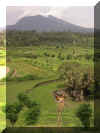 waving
enthusiastically at strangers, people preparing bamboo “dragons” that bend
gracefully over the road and placing offerings for their doorsteps. It's
the school kids
in earthy brown and printed uniforms (a welcome change from the standard blue
and white we’ve seen nearly everywhere else), temples with a steady procession
of worshippers in their best clothes, and women
with fruit offerings on their heads. Once
on the road with these views, we immediately stated to relax and enjoy
ourselves. Out here, you see how religion
takes such a central place in the Balinese culture - temples are everywhere,
people bow, smile and show respect, and offerings are left in the street every
few steps in the morning.
waving
enthusiastically at strangers, people preparing bamboo “dragons” that bend
gracefully over the road and placing offerings for their doorsteps. It's
the school kids
in earthy brown and printed uniforms (a welcome change from the standard blue
and white we’ve seen nearly everywhere else), temples with a steady procession
of worshippers in their best clothes, and women
with fruit offerings on their heads. Once
on the road with these views, we immediately stated to relax and enjoy
ourselves. Out here, you see how religion
takes such a central place in the Balinese culture - temples are everywhere,
people bow, smile and show respect, and offerings are left in the street every
few steps in the morning.
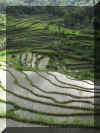 On
the way to Candidassa we saw a somber cremation ceremony by the road.
We had lunch at Candidassa at an over-priced tourist restaurant
overlooking what used to be a beach until developers harvested the coral reef
protecting it to make cement for ugly gray hotels. Now the beach is gone
at high tide and black muck is exposed at low tide . In the parking
lot, a guy offered us fake marijuana and even more ridiculous
designer watches. We were glad to be out of there and the scenery up into the hills continued to astound – we
kept stopping and couldn’t get enough photos of the vast terraces, swirling
and curving down the emerald mountainsides like giant footsteps.
On
the way to Candidassa we saw a somber cremation ceremony by the road.
We had lunch at Candidassa at an over-priced tourist restaurant
overlooking what used to be a beach until developers harvested the coral reef
protecting it to make cement for ugly gray hotels. Now the beach is gone
at high tide and black muck is exposed at low tide . In the parking
lot, a guy offered us fake marijuana and even more ridiculous
designer watches. We were glad to be out of there and the scenery up into the hills continued to astound – we
kept stopping and couldn’t get enough photos of the vast terraces, swirling
and curving down the emerald mountainsides like giant footsteps.
The paradise was broken only by a group of kids whose only
English was “give money” and a group of teenagers relieving themselves in
the street with a laugh. We found a
small hotel in the middle of rice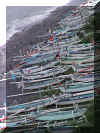 terraces, then continued to drive to Amed, on the North coast.
The beach there was black volcanic rock, with hundreds of fishing boats
and outrigger canoes pulled up to shore. Unfortunately,
the dive shop there said the weather was too bad for diving.
After messing with a broken window on the jeep, we decided to take the
long way around the eastern tip of the island and back to Tirta.
That was a big mistake, not that we knew it at the time. The road was completely washed away at points leaving only
rocky foundations and huge, suspension-twisting holes and cliffs.
We had not driven a car since we left LA, so it was great fun, although
we didn’t know if the jeep would make it.
The problem was we were doing off-road four-wheeling on the road with a
wimpy little jeep without 4WD. It
was pretty fun for the first hour, bounding along, watching the waves crash the
beach, but after 2 hours we were dreaming of our soft beds.
The sunset and subsequent darkness didn’t help as the cliffs we
previously spotted at 20 meters, now seemed to come out of nowhere to devour our
tires. The “road” was one lane
without shoulders and overgrown with weeds like a jungle path.
Although on the map road was just as solid and dark as the other
roads, most people would say it warranted a dotted line at best to indicate
unpaved or no mention at all. The
locals looked at us with a mixture of surprise and wonder, first at seeing any
vehicle approach, then when they realized a white guy was driving.
We were happy to provide the evening entertainment for dozens of villages
and hundreds of kids, not to mention some fairly amused adults. There were a few
times we thought we were history (or at least a funny footnote in local
history), but we have to say the Suzuki help up pretty well – and we only
grinded the gears once – which we thought was pretty good under the
circumstances. We felt really sorry
for the owner because we got way more than $8 worth of usage out of the thing today.
By the time we limped back to Tirta, two and a half hours into what would
have been a half hour the other way, all the restaurants were closing, so we
went the only place we could to eat.. It was
nice, but the real treat was joining the guys hanging out at the
general store when we stopped there for water.
There was a group of young guys and one family chatting with two Japanese
tourists. An older guy was playing his handmade flutes, which he was
quickly sorry he gave me to try out (as was everyone else).
They told us about a temple ceremony tomorrow and invited us to a special
family party celebrating a sister’s newborn baby.
We can’t wait. Buti was
playing guitar and we sang along to Bob Marley (sort of).
It looks like Bob has beaten out the Eagles and (thankfully) Britney Spears as
the primary soundtrack of our world tour. After he sang “One Love”, we shared the One World Foundation idea
with them. They loved it and promised to display the stickers prominently. They also gave some lively interviews:
terraces, then continued to drive to Amed, on the North coast.
The beach there was black volcanic rock, with hundreds of fishing boats
and outrigger canoes pulled up to shore. Unfortunately,
the dive shop there said the weather was too bad for diving.
After messing with a broken window on the jeep, we decided to take the
long way around the eastern tip of the island and back to Tirta.
That was a big mistake, not that we knew it at the time. The road was completely washed away at points leaving only
rocky foundations and huge, suspension-twisting holes and cliffs.
We had not driven a car since we left LA, so it was great fun, although
we didn’t know if the jeep would make it.
The problem was we were doing off-road four-wheeling on the road with a
wimpy little jeep without 4WD. It
was pretty fun for the first hour, bounding along, watching the waves crash the
beach, but after 2 hours we were dreaming of our soft beds.
The sunset and subsequent darkness didn’t help as the cliffs we
previously spotted at 20 meters, now seemed to come out of nowhere to devour our
tires. The “road” was one lane
without shoulders and overgrown with weeds like a jungle path.
Although on the map road was just as solid and dark as the other
roads, most people would say it warranted a dotted line at best to indicate
unpaved or no mention at all. The
locals looked at us with a mixture of surprise and wonder, first at seeing any
vehicle approach, then when they realized a white guy was driving.
We were happy to provide the evening entertainment for dozens of villages
and hundreds of kids, not to mention some fairly amused adults. There were a few
times we thought we were history (or at least a funny footnote in local
history), but we have to say the Suzuki help up pretty well – and we only
grinded the gears once – which we thought was pretty good under the
circumstances. We felt really sorry
for the owner because we got way more than $8 worth of usage out of the thing today.
By the time we limped back to Tirta, two and a half hours into what would
have been a half hour the other way, all the restaurants were closing, so we
went the only place we could to eat.. It was
nice, but the real treat was joining the guys hanging out at the
general store when we stopped there for water.
There was a group of young guys and one family chatting with two Japanese
tourists. An older guy was playing his handmade flutes, which he was
quickly sorry he gave me to try out (as was everyone else).
They told us about a temple ceremony tomorrow and invited us to a special
family party celebrating a sister’s newborn baby.
We can’t wait. Buti was
playing guitar and we sang along to Bob Marley (sort of).
It looks like Bob has beaten out the Eagles and (thankfully) Britney Spears as
the primary soundtrack of our world tour. After he sang “One Love”, we shared the One World Foundation idea
with them. They loved it and promised to display the stickers prominently. They also gave some lively interviews:
 "Friends.
Because even if you have money, but no friends, it has no meaning. Like
right now, together like this. We are here and I have no money - just
guitar. I learn this from Bob Marley."
"Friends.
Because even if you have money, but no friends, it has no meaning. Like
right now, together like this. We are here and I have no money - just
guitar. I learn this from Bob Marley."
"I think the same - friends"

"Friends and girlfriends. I like people from other countries to come
to Bali and make friends - like you"
"I like to play my flutes with friends"
"Just to enjoy my life"
"My family is most important"
The evening turned out to be the exact opposite of this
morning. Ah, the wonders of travel
in a strange place.
*******
Day 282, Sun, Feb. 11, 2001 – We slept in after
the long night with those guys. After
a nice continental breakfast on our bamboo wicker balcony, we went to their
shop to buy sarongs and sashes.  We
each feel a bit silly, but I have to say Naomi is a little bit more accustomed
to wearing a skirt. We knew we were
ripped off on the price, but we wrote it off to supporting the local economy
(besides, that’s the minor type of larceny compared
We
each feel a bit silly, but I have to say Naomi is a little bit more accustomed
to wearing a skirt. We knew we were
ripped off on the price, but we wrote it off to supporting the local economy
(besides, that’s the minor type of larceny compared  to
the police corruption and elaborate deception of yesterday).
We headed for Puri Lampanyung, up the slopes of Mt. Agung.
We had to pull over to let buses turn around and pass us down the hill.
to
the police corruption and elaborate deception of yesterday).
We headed for Puri Lampanyung, up the slopes of Mt. Agung.
We had to pull over to let buses turn around and pass us down the hill.
At the temple, we were the only tourists, so of course we were the center
of attention. Kids yelled
“Hello!” back at our “Salamat Pinga”, men smiled and nodded and women
laughed and covered their mouths. Their
conservative ankle-length sarongs were complemented by beautiful makeup,
tasteful jewelry, and flowers in their pinned and braided hair.
They had a virtuous beauty not unlike the women in ao dais in Vietnam.
The women 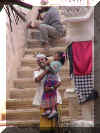 were
in groups weaving baskets from banana and palm leaves for offerings while men
were busy carving sticks for satay and grounding up coconut flesh.
Younger boys carried things about, gossiped in little groups and flirted
(oh so casually) with groups of single girls.
All eyes followed us as we smiled and nodded our way past these groups,
up a slippery mud slope to the temple courtyard.
There were even more groups up there, in front of the three long
staircases leading to the main temple, which was recently rebuilt in gleaming
stone and plaster. The smiling and
pointing continued until one woman responded in English to our greeting. She
told us that it was OK to be there and that we could take photos (although we were the
only foreigners), but we probably should not go up the stairs.
We took several photos
were
in groups weaving baskets from banana and palm leaves for offerings while men
were busy carving sticks for satay and grounding up coconut flesh.
Younger boys carried things about, gossiped in little groups and flirted
(oh so casually) with groups of single girls.
All eyes followed us as we smiled and nodded our way past these groups,
up a slippery mud slope to the temple courtyard.
There were even more groups up there, in front of the three long
staircases leading to the main temple, which was recently rebuilt in gleaming
stone and plaster. The smiling and
pointing continued until one woman responded in English to our greeting. She
told us that it was OK to be there and that we could take photos (although we were the
only foreigners), but we probably should not go up the stairs.
We took several photos  of
the temple, decked out with flags and offerings and of the groups working away
on the offerings for an upcoming festival on March 1.
of
the temple, decked out with flags and offerings and of the groups working away
on the offerings for an upcoming festival on March 1.
 The woman, Made, explained that this is a special temple for people from
all over Bali and they come in groups by bus and truck in the morning to work
all day. Many people came today
because they have a holiday from their jobs.
They will work and prepare for the festivities each weekend (and some
people every day) for the next three weeks.
It was great seeing whole communities come together for a common cause so
naturally, demonstrating that the true benefit of religion is in creating
brotherhood and togetherness while we are here, not in trying to orchestrate
what will happen when we die. In
the US, it takes a hurricane or earthquake to bring a community together for the
common good. It does seem like a paradise of unity, but there is a
trade-off in the lack of individual freedom - nearly everything in life is a
community issue governed by the community "Banjar" which every man must join when
he marries. Rice growing, harvesting, jobs, marriage, family, and religion,
are all community-managed. We asked Made about the meaning of all the ceremonies
and rituals, and she said some don't have a meaning - they say "Mula
Keto" (“that’s just the way it’s done”). In many cases, there
is no symbolism at all. There is however, symbolism in the offerings
or Canang Sari. They make take many shapes and sizes, but usually
includes a base of young coconut leaves held
The woman, Made, explained that this is a special temple for people from
all over Bali and they come in groups by bus and truck in the morning to work
all day. Many people came today
because they have a holiday from their jobs.
They will work and prepare for the festivities each weekend (and some
people every day) for the next three weeks.
It was great seeing whole communities come together for a common cause so
naturally, demonstrating that the true benefit of religion is in creating
brotherhood and togetherness while we are here, not in trying to orchestrate
what will happen when we die. In
the US, it takes a hurricane or earthquake to bring a community together for the
common good. It does seem like a paradise of unity, but there is a
trade-off in the lack of individual freedom - nearly everything in life is a
community issue governed by the community "Banjar" which every man must join when
he marries. Rice growing, harvesting, jobs, marriage, family, and religion,
are all community-managed. We asked Made about the meaning of all the ceremonies
and rituals, and she said some don't have a meaning - they say "Mula
Keto" (“that’s just the way it’s done”). In many cases, there
is no symbolism at all. There is however, symbolism in the offerings
or Canang Sari. They make take many shapes and sizes, but usually
includes a base of young coconut leaves held with bamboo skewers, fruit, nuts, cake, and flowers, which must be fresh and
fragrant. The whole thing is then sprinkled with a flower dipped in holy water
and a prayer is said and
incense is burned so the prayer and offering can be delivered on the smoke
curling up to the heavens. They
pray over the offering inside the temple, then take it home and eat it
themselves since the gods don’t really need it.
Made insisted we try some, so Naomi had papaya and I tried the bitter, but
somehow enticing "snakefruit". She was missing her 4-year old at home, so she asked if her and
her could
accompany us for the day and be dropped back home.
It was good for us too, because we always like a local guide, especially
a friend, to ask all of our questions.
with bamboo skewers, fruit, nuts, cake, and flowers, which must be fresh and
fragrant. The whole thing is then sprinkled with a flower dipped in holy water
and a prayer is said and
incense is burned so the prayer and offering can be delivered on the smoke
curling up to the heavens. They
pray over the offering inside the temple, then take it home and eat it
themselves since the gods don’t really need it.
Made insisted we try some, so Naomi had papaya and I tried the bitter, but
somehow enticing "snakefruit". She was missing her 4-year old at home, so she asked if her and
her could
accompany us for the day and be dropped back home.
It was good for us too, because we always like a local guide, especially
a friend, to ask all of our questions.
We drove nearly two hours through beautiful scenery up
Agung to the Besakih temple, the “mother temple” of all of Bali.
The complex of 22 temples is the most important in Bali, with roots back 2,000
years, and it 
 attracts
worshippers from all over the island, especially at festival and ceremony time.
It was here that the Eka Dasa Rudra festival that only occurs every 100
years was interrupted by the eruption of the Mt. Gunung volcano in 1963, that
also apparently signaled the beginning of the end for Sukarno and the beginning
of the reign of Suharto. We asked
Made about the situation with Wahid and she said she really could not tell, but
she thinks he is not good for the economy because prices keep rising, but jobs
are still as scarce as they were when he took office.
They hope the violence of Java does not stretch the 30 miles across the
Java straits to the peaceful shores of Bali.
She said that poor people always suffer the most in any political system
– even a democracy like the US. We
could hardly disagree with her.
attracts
worshippers from all over the island, especially at festival and ceremony time.
It was here that the Eka Dasa Rudra festival that only occurs every 100
years was interrupted by the eruption of the Mt. Gunung volcano in 1963, that
also apparently signaled the beginning of the end for Sukarno and the beginning
of the reign of Suharto. We asked
Made about the situation with Wahid and she said she really could not tell, but
she thinks he is not good for the economy because prices keep rising, but jobs
are still as scarce as they were when he took office.
They hope the violence of Java does not stretch the 30 miles across the
Java straits to the peaceful shores of Bali.
She said that poor people always suffer the most in any political system
– even a democracy like the US. We
could hardly disagree with her.
We
continued down the hill from the temple to
 Klungklung
which sounds like the sound of a gamelan orchestra, but is the home of the 17th
century Hall of Justice, with its illustrative paintings of mythological and
religious scenes. The meaning of
the numerous scenes is open to interpretation and varies from guidebook to
guidebook. A local guide latched
onto us and explained that the floating palace where Buddhist scenes and the Hall
of Justice was Hindu and the four doves above it
Klungklung
which sounds like the sound of a gamelan orchestra, but is the home of the 17th
century Hall of Justice, with its illustrative paintings of mythological and
religious scenes. The meaning of
the numerous scenes is open to interpretation and varies from guidebook to
guidebook. A local guide latched
onto us and explained that the floating palace where Buddhist scenes and the Hall
of Justice was Hindu and the four doves above it  symbolize
the four religions of Bali (Hindu, Buddhist, Muslim and Christian) living in
harmony and peace. This wasn't
exactly the same as the Lonely Planet description. Regardless
of explanation, the scenes were certainly energetic and entertaining, with some
zodiac symbolism, pitched battles
symbolize
the four religions of Bali (Hindu, Buddhist, Muslim and Christian) living in
harmony and peace. This wasn't
exactly the same as the Lonely Planet description. Regardless
of explanation, the scenes were certainly energetic and entertaining, with some
zodiac symbolism, pitched battles  with
blood spurting and headless warriors, romantic scenes from a wedding and
honeymoon, gods fighting demons, and scenes of horrific punishments in hell.
These images of people being stabbed, burned, driven like oxen, etc.
reminded us of the Catholic images of hell in Italy and Spain.
The depiction of adulterers taking a fiery torch in the crotch was
virtually identical to the scene on the cupola of the Duomo in Florence.
with
blood spurting and headless warriors, romantic scenes from a wedding and
honeymoon, gods fighting demons, and scenes of horrific punishments in hell.
These images of people being stabbed, burned, driven like oxen, etc.
reminded us of the Catholic images of hell in Italy and Spain.
The depiction of adulterers taking a fiery torch in the crotch was
virtually identical to the scene on the cupola of the Duomo in Florence.
We certainly understood the message of bad behavior leading
to hell, but didn’t quite reconcile that with the theory of continual rebirth
until you get it right. I’m sure
we’re missing something, as usual. One thing we didn’t miss was a particularly gruesome scene,
which our guide said depicted the punishment for the “immoral behavior” of
flatulence (you can use your imagination for this one).
I really wish he had told me before I had that curry last night.
By the time we were out of there, we were all dead tired and Said was
nodding off in the back of the car. I
think they would have fallen asleep completely if it wasn’t for a few
heart-attack-inducing close calls we had on some road curves.
The moped to truck to car ratio in Bali is about 10 to 5 to 1, so there
are always vehicles zooming around you (mopeds) or running you off the road
(trucks) – even in the countryside and small towns.
When we got to their house in the jungle off the highway,
we were treated to fresh coconut water from a  nut
that Said’s brother cut down from a tree in the field next to the house.
It was a scene of mellow country bliss, with chickens, pigs, and dogs running
around and fruit everywhere. Said’s
daughter was a bit shy, but rambunctious, demonstrating why her mother thought
it
was better not to take her to the temple. They
explained that the government does not pay for school or healthcare unless you are
very poor. When we asked where
their tax money went, they had no idea. When
we suggested that the Suharto family probably has it all, they just laughed.
We exchanged addresses and she invited us to stay with them in Denpasar
when we return from Lombok. We said
goodbye as we still had an hour drive ahead of us and they had to return 1.5
hours the other direction to Denpasar. By
the time we got home after such a long day Naomi was dead tired and I had a sore
throat, so we had to pass on the party for the newborn baby.
Kuta was very understanding and wished us well.
We just ate a light meal at the Good Karma Restaurant and crashed.
nut
that Said’s brother cut down from a tree in the field next to the house.
It was a scene of mellow country bliss, with chickens, pigs, and dogs running
around and fruit everywhere. Said’s
daughter was a bit shy, but rambunctious, demonstrating why her mother thought
it
was better not to take her to the temple. They
explained that the government does not pay for school or healthcare unless you are
very poor. When we asked where
their tax money went, they had no idea. When
we suggested that the Suharto family probably has it all, they just laughed.
We exchanged addresses and she invited us to stay with them in Denpasar
when we return from Lombok. We said
goodbye as we still had an hour drive ahead of us and they had to return 1.5
hours the other direction to Denpasar. By
the time we got home after such a long day Naomi was dead tired and I had a sore
throat, so we had to pass on the party for the newborn baby.
Kuta was very understanding and wished us well.
We just ate a light meal at the Good Karma Restaurant and crashed.
*******
If you would like to follow our adventure in Bali, please click here: Photojournal February 12 - 16, 2001
If you have any comments, suggestions, or other feedback, please see our contact information and send us a note.
Thanks for your support!
